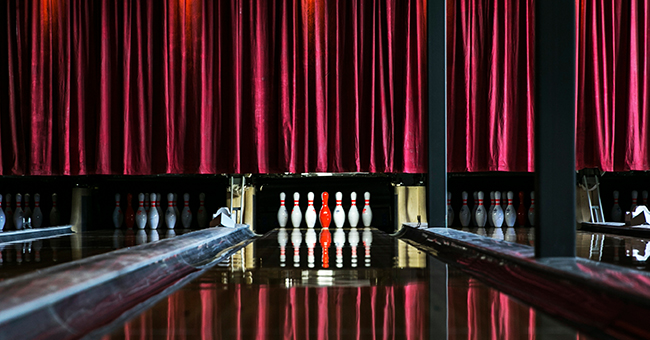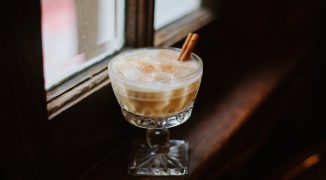Bowling and drinking are two American pastimes that go hand in hand. And while we can’t claim to be the innovator of either, we’ve certainly perfected the art of both. All over the country, high-end bowling culture is experiencing a wave of growth with the resurgence of boutique bowling alleys aimed at pairing craft cocktails and gourmet bar food with the ten pin tradition.
In America, bowling dates all the way back to the 1700s when European settlers brought the game over from Britain, France and the Netherlands. The rapid, nation-wide growth of the game sprung out of New York City, where many bowling clubs and outdoor bowling greens originated, including Bowling Green Park in Manhattan. Immigrants traveling through New York City picked up the game and took it with them all over the country.
One of the first and most popular bowling games of the day was Nine Pin, a reference to the number of pins used to play it. Associated with gambling and drinking, this particular game was most common before and during Prohibition. During that era, indoor bowling alleys would become some of the most prominent speakeasy spaces, as the culture of bowling was one already entangled with other “illicit” activities. To circumvent the Prohibition laws that came about to eliminate Nine Pin and its ties to gambling and drinking, players added a pin to the game and rebranded the sport as “bowling,” thus creating the ten pin game we know today.
Because bowling’s origins in the U.S. are thoroughly entrenched in cocktail culture, today’s resurgence seems a natural homage to the Prohibition era. High-end boutique bowling spots from Hollywood to Atlanta have seamlessly captured the aesthetic of the speakeasy bowling establishment to create a new experience for guests seeking to enjoy the classic pastime.
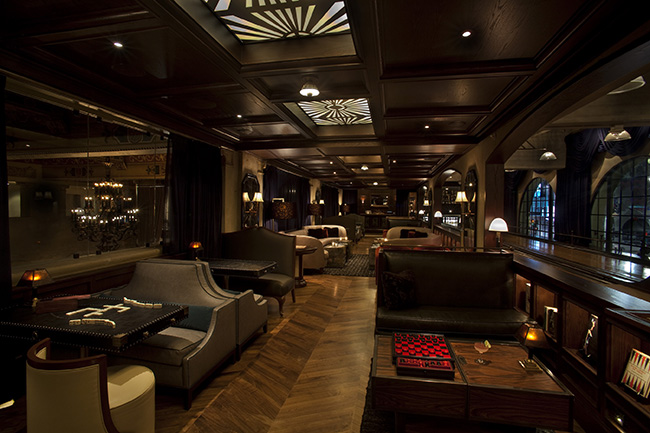 Hollywood’s The Spare Room was one of the first to connect America’s unique and interconnected history of cocktails and gaming. (Photo: The Spare Room.)
Hollywood’s The Spare Room was one of the first to connect America’s unique and interconnected history of cocktails and gaming. (Photo: The Spare Room.)
Perhaps the first of its kind, The Spare Room opened in Hollywood in 2010. Conceptualized by owners Med Abrous and Marc Rose, The Spare Room is a beautifully crafted space featuring 1940’s maple and pine lanes, custom bowling shoes designed by George Esquivel, and even a hidden photo booth somewhere on the premises. Marc Rose explains that the genesis of the concept came as an extension of the “game night” trend happening all over Los Angeles at the time. “While we too had lots of fun at our friends’ homes, we found the experience to be missing a few key elements and thought that we could find a way to take the camaraderie of gaming and elevate the experience,” says Rose.
Basing a lot of their concept on the parlor rooms of renowned families like the Vanderbilts and the Rockefellers, who built bowling lanes and game rooms into their lavish homes, Abrous and Rose decided to bring a higher level of experience to L.A. Each game featured at The Spare Room is custom made, including Jenga, Backgammon and Monopoly. With such attention to detail and an emphasis on creating an experience, Abrous and Rose have built a space where people can come relax, drink, eat good food and play games. “The idea of games and competition sets the stage for patrons to interact and come together in a unique way,” Rose says.
The Spare Room is known for their tailor-made cocktails, which enhance the overall experience of the space by tapping into the Prohibition era nostalgia for craft cocktails. One of their most popular offerings are punch bowls crafted with fresh ingredients and served in classic fashion. The punch bowl style of drinking allows patrons to stay at their lanes or at their tables without a visit to the bar every time they want a drink. Punch bowls are The Spare Room’s throwback answer to bottle service without the pretense. But that isn’t their only purpose, according to Rose. “They enforce our goal of wanting groups to interact with each other and create their own moments within the larger space.”
This, after all, is the central reason The Spare Room came to be — to create a place where people can come play games, enjoy a good drink and be with friends. But, as Rose notes, “at the end of the day, we’re a bar.” And their bar program is at the heart of the experience. With Yael Vengroff at the helm, each cocktail is just as hand-crafted as the parlor games. Rose says their standout cocktail is the “Lucky Smoke,” a Japanese whiskey and Jamaican rum based cocktail paired with their custom-made Miracle Mile Bitters, banana liqueur and vanilla. Other favorites include the tequila-based “Riptide Rush” garnished with a flashing ice cube and the “Dark and Stormborn,” a twist on the classic with Fernet Branca and a few Game of Thrones references.
 Both the bar program and the aesthetic of Atlanta’s Painted Pin prize all things Prohibition-era. (Photo: The Painted Pin.)
Both the bar program and the aesthetic of Atlanta’s Painted Pin prize all things Prohibition-era. (Photo: The Painted Pin.)
The Spare Room is perhaps the first of it’s kind, but it’s not the only high-end bowling establishment to open in recent years. Atlanta’s Painted Pin opened in 2014 thanks to owners Justin Amick and William Stallworth’s shared love for bowling and competitive games. The concept originated when the pair realized they could fill a void in the market for alternative forms of entertainment. Bowling is the heart of the concept, but the Painted Pin also boasts custom indoor bocce courts, two oversized basketball pop a shots, table shuffleboard, ping pong, skee-ball, giant Jenga and Southern skittles.
As well as serving up craft comfort foods like house-made pretzel bites and cheddar ranch pork rinds courtesy of Chef Thomas Collins, the Painted Pin houses a beautiful full-service bar in the center of the space. Bar Manager Trip Sandifer serves signature and classic cocktails, like their beloved Moscow Mule Slushy and bourbon punch. “Amick and Sandifer come from a lifetime in the restaurant industry,” says Painted Hospitality representative Hannah Amick. “Their shared passion for all things beverage is evident in the attention to detail, quality, and breadth of offerings.” The bar program prioritizes the history of Prohibition era cocktail culture without any pretension, just like the space itself.
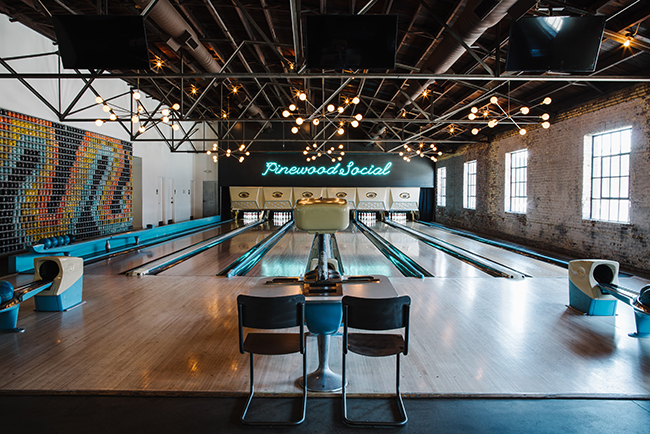 At Nashville’s Pinewood Social, guests can entertain themselves and commune all day with a host of activities ranging from bowling to swimming to eating and drinking. (Photo: Andrew Thomas Lee)
At Nashville’s Pinewood Social, guests can entertain themselves and commune all day with a host of activities ranging from bowling to swimming to eating and drinking. (Photo: Andrew Thomas Lee)
Just a few hours northwest of Atlanta, Nashville’s Pinewood Social is yet another boutique bowling establishment catering to the market of competitive entertainment. Brothers and owners Benjamin and Max Goldberg of Strategic Hospitality conceptualized Pinewood Social in New York while sitting in a hotel lobby working all day. Communications Director Tara Tocco explains that the central idea was a desire for a “third space” based on Ray Oldenburg’s book “The Great Good Place.” “They started talking about how great it would be if they could go somewhere, order food throughout the day and just camp out. So they started chewing on the idea, and it evolved from there… [it’s] a place to work, to chat, to compete, a gathering place in a community that welcomes all for whatever they need to do. When they found the empty 13,000 square foot building in Rolling Mill Hill in Nashville they knew they had found the right space for their third space.”
Not only is Pinewood Social a bowling alley with games like ping pong and bocce ball, it also has an expanded outdoor area with lounge chairs, a patio and two pools complete with a shiny silver airstream bar, one of two bars in the space that serve up beverage director Matt Tocco’s craft creations. Currently on the menu are bestsellers “The Devil Sits Ringside,” a vodka based cocktail with pear, grapefruit and grenadine, and “Steel Cut Old Fashioned,” with oatmeal infused rye whiskey, maple syrup and spiced cherry bitters. According to Tocco, “Both drinks are quite simple and delicious,” as the goal is be accessible but also provide a little something different to the diverse clientele.
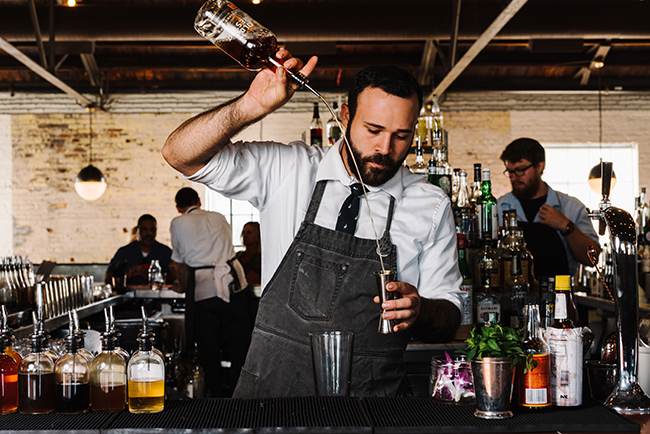 Pinewood Social’s bar is at the heart of what the space serves — hospitality, community and entertainment. (Photo: Andrew Thomas Lee)
Pinewood Social’s bar is at the heart of what the space serves — hospitality, community and entertainment. (Photo: Andrew Thomas Lee)
At Pinewood Social, each element is another texture of the experience. “I feel as though the bar is another layer to the onion that is Pinewood,” says Tocco. “You can sit at the bar and watch the show and interact with the bartenders or you can drink a Negroni or even a High Life while you bowl.” The Goldberg brothers’ “third space” is designed to create an individualized experience, whether with friends, family or by yourself.
At the heart of all of these high-end bowling establishments is a desire to curate an experience tailored to each individual guest. By embracing the Prohibition-era aesthetic, with all its glamour, debauchery and deliciously boozy drinks, these spaces are zoning in on a desire to return to a bygone time. Bowling and playing games with friends are nostalgic pastimes that, in these spaces, are reinvented into present-day adventures. Craft cocktail culture is a large part of the equation, but it goes hand in hand with the impulse to make new memories in places that allow us to return to another era, if only for a night.


